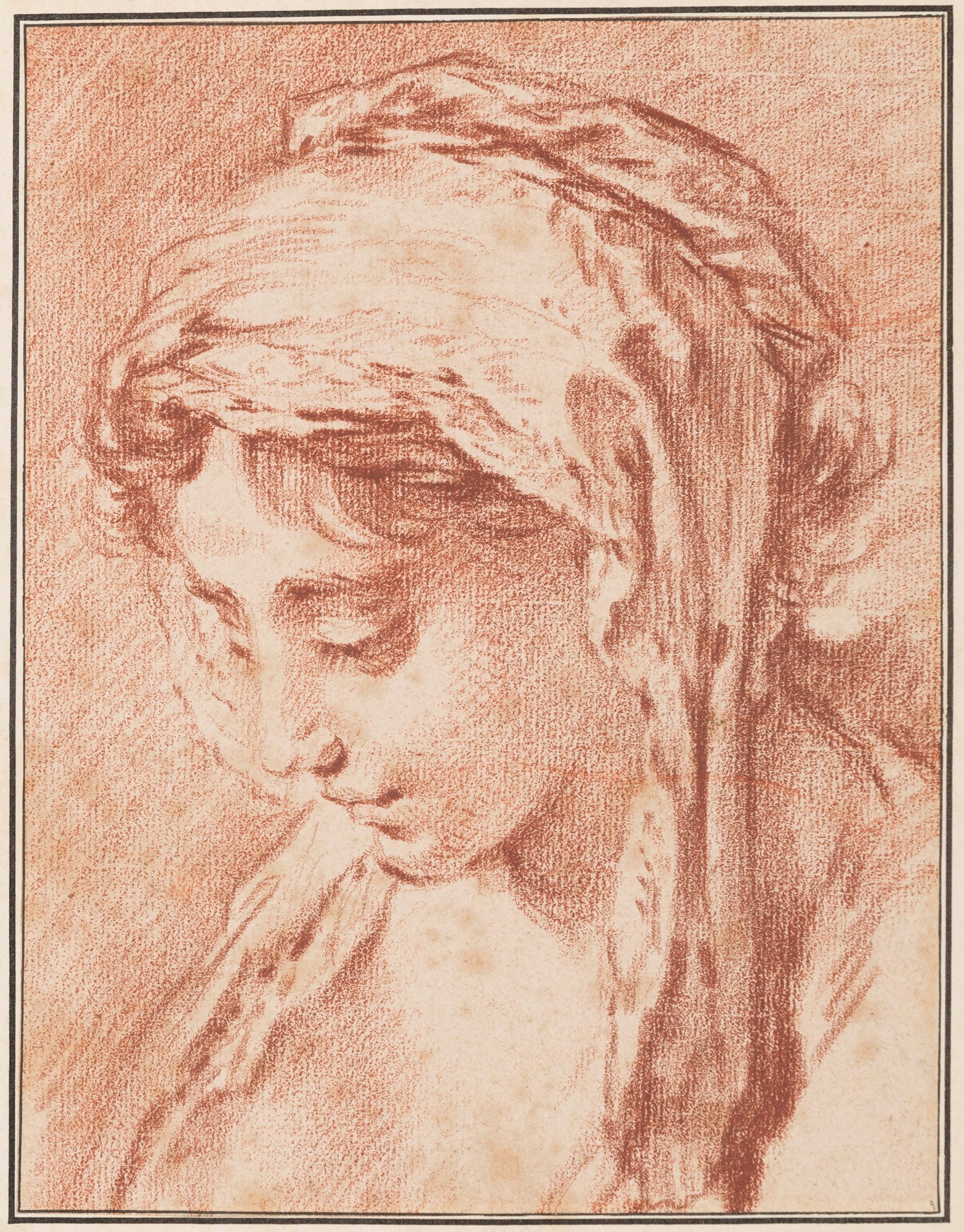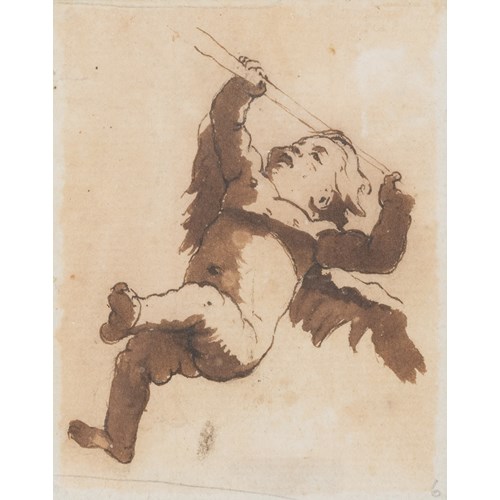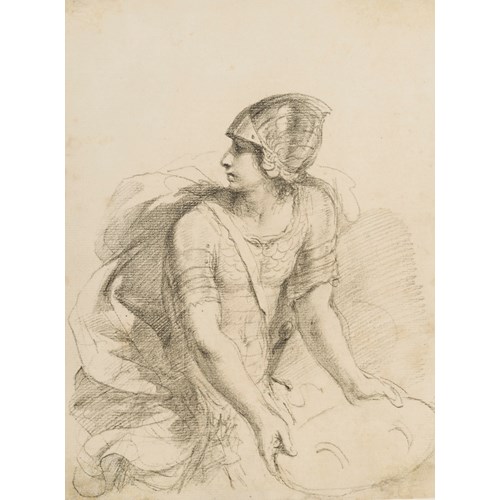Marketplace
The Head of a Young Woman with a Headscarf, Looking Down to the Left
François Boucher
The Head of a Young Woman with a Headscarf, Looking Down to the Left
François Boucher’s drawings were greatly admired by his contemporaries, and were reproduced by engravers such as Gilles Demarteau, Gabriel Huquier and Louis-Marin Bonnet. Indeed, his popularity as a draughtsman owes much to the fact that many of his drawings were reproduced and widely distributed as engravings, with over a thousand individual drawings by Boucher replicated in the form of prints. As the French gazette Mercure de France noted in 1762, ‘Engravings after the famous Boucher are very sought after today, and his taste seems to have become that of all the Amateurs.’
The present sheet was, in fact, used as the model for two different prints. It was reproduced, in reverse, in an etching by Jacques Gabriel Huquier the Younger (1725-1805), while another print after the same drawing – a red-chalk manner engraving in the same direction as the present sheet, but with the composition extended at the bottom so as to depict a three-quarter length figure – was published by Gilles Demarteau (1722-1776), a printmaker who specialized in this type of coloured engraving.
When this drawing was included in an exhibition of paintings and drawings by François Boucher from private collections, held at the Musée Lambinet in Versailles in 2004, the Boucher scholar Françoise Joulie wrote of it at length: ‘Wearing a lace headscarf, the transparency of which is suggested by the white reserve of the paper, this woman in profile could not have been done before the 1760s. The red chalk chosen by the artist is that of his later years, ever darker and darker; it is treated extensively to suggest the folds of the kerchief falling over the throat or the curls of hair escaping from the headdress, finely hatched over the cheek to give it volume and suggest the roundness of this part of the face in shadow; on the other hand, it is used with precision to emphasise the crease of the lip and to detail one by one the eyelashes shading the eyes, in a process characteristic of the artist’s maturity. The face stands out against a background of sober hatching, which Boucher was able to interrupt on the left-hand side of the sheet to show the light fabric running down the cheek; in so doing, he suggested a volume that the light illuminating the nape of his model’s neck confirms. The drawing is lit from the top left-hand corner, so that the top of the kerchief and the rounded forehead are left white, while the chin casts its shadow over the neck. This masterly illumination, the young woman’s pensive smile and the secrecy of a gaze that turns away give this seemingly simple head study, engraved by Demarteau and Huquier, a profound inner life.’
The late Boucher scholar Alastair Laing noted an analogy between the present sheet, as reproduced in prints by Huquier fils and Demarteau, and the head of the kitchen maid in Boucher’s small painting La belle cuisinière (The Beautiful Kitchen Maid), datable to c.1733-1734, in the collection of the Musée Cognac-Jay in Paris8. However, as he noted, in the drawing the head is ‘studied at a slightly different angle and in a more elaborate kerchief’ than in the painting.
According to the caption on the red-chalk manner engraving after this drawing by Gilles Demarteau, the first owner of the present sheet was Charles Marin de La Haye des Fossés (1736-1790), fermier general du roi and adminstrateur des postes de France. Marin de la Haye was one of a number of contemporary collectors who acquired drawings by Boucher, and he may have been encouraged to do so by his older sister, Catherine-Charlotte-Edmée de la Haye des Fossés, and her husband, Barthelémy-Augustin Blondel d’Azaincourt, who between them assembled a group of several hundred drawings by the artist. Marin de la Haye’s wife, Marie Adélaïde Victoire Bouret, also owned a number of drawings by Boucher, while another of his sisters was married to Jean-François Bergeret de Frouville, likewise a patron of Boucher and the younger brother of one of the artist’s greatest patrons and collectors, Pierre-Jacques-Onésyme Bergeret de Grancourt. As Alastair Laing has pointed out, ‘The four members of the de la Haye and Blondel d’Azaincourt families were thus not only between them the major collectors of Boucher’s drawings - Blondel d’Azaincourt was said in 1766 to have owned almost 500 of them – and particularly of those that they lent to be engraved as chalk-manner prints, but they were also thus linked to two of Boucher’s major patrons for paintings in the latter part of his life, Bergeret de Grancourt…and Bergeret de Frouville.’
Laing has further noted that, ‘In the case of the major makers and publishers of chalk-manner engravings, Gilles Demarteau the Elder and Louis-Marin Bonnet, their procurement of drawings to be engraved fed directly off [another] factor encouraging Boucher’s production of autonomous drawings: the rise of the dedicated collector…in the case of Bonnet and Demarteau many of their prints of Boucher’s drawings…specifically proclaim themselves as done after originals in the cabinet, or collection, of particular collectors. Evidently, in the case of certain collectors of Boucher’s drawings, it was not enough to enjoy the possession of them; their publication also boosted the reputation of their owner as a true connoisseur.’ Marin de la Haye owned at least thirty-five drawings by Boucher that were reproduced as engravings, while his wife owned a further three.
The present sheet was, in fact, used as the model for two different prints. It was reproduced, in reverse, in an etching by Jacques Gabriel Huquier the Younger (1725-1805), while another print after the same drawing – a red-chalk manner engraving in the same direction as the present sheet, but with the composition extended at the bottom so as to depict a three-quarter length figure – was published by Gilles Demarteau (1722-1776), a printmaker who specialized in this type of coloured engraving.
When this drawing was included in an exhibition of paintings and drawings by François Boucher from private collections, held at the Musée Lambinet in Versailles in 2004, the Boucher scholar Françoise Joulie wrote of it at length: ‘Wearing a lace headscarf, the transparency of which is suggested by the white reserve of the paper, this woman in profile could not have been done before the 1760s. The red chalk chosen by the artist is that of his later years, ever darker and darker; it is treated extensively to suggest the folds of the kerchief falling over the throat or the curls of hair escaping from the headdress, finely hatched over the cheek to give it volume and suggest the roundness of this part of the face in shadow; on the other hand, it is used with precision to emphasise the crease of the lip and to detail one by one the eyelashes shading the eyes, in a process characteristic of the artist’s maturity. The face stands out against a background of sober hatching, which Boucher was able to interrupt on the left-hand side of the sheet to show the light fabric running down the cheek; in so doing, he suggested a volume that the light illuminating the nape of his model’s neck confirms. The drawing is lit from the top left-hand corner, so that the top of the kerchief and the rounded forehead are left white, while the chin casts its shadow over the neck. This masterly illumination, the young woman’s pensive smile and the secrecy of a gaze that turns away give this seemingly simple head study, engraved by Demarteau and Huquier, a profound inner life.’
The late Boucher scholar Alastair Laing noted an analogy between the present sheet, as reproduced in prints by Huquier fils and Demarteau, and the head of the kitchen maid in Boucher’s small painting La belle cuisinière (The Beautiful Kitchen Maid), datable to c.1733-1734, in the collection of the Musée Cognac-Jay in Paris8. However, as he noted, in the drawing the head is ‘studied at a slightly different angle and in a more elaborate kerchief’ than in the painting.
According to the caption on the red-chalk manner engraving after this drawing by Gilles Demarteau, the first owner of the present sheet was Charles Marin de La Haye des Fossés (1736-1790), fermier general du roi and adminstrateur des postes de France. Marin de la Haye was one of a number of contemporary collectors who acquired drawings by Boucher, and he may have been encouraged to do so by his older sister, Catherine-Charlotte-Edmée de la Haye des Fossés, and her husband, Barthelémy-Augustin Blondel d’Azaincourt, who between them assembled a group of several hundred drawings by the artist. Marin de la Haye’s wife, Marie Adélaïde Victoire Bouret, also owned a number of drawings by Boucher, while another of his sisters was married to Jean-François Bergeret de Frouville, likewise a patron of Boucher and the younger brother of one of the artist’s greatest patrons and collectors, Pierre-Jacques-Onésyme Bergeret de Grancourt. As Alastair Laing has pointed out, ‘The four members of the de la Haye and Blondel d’Azaincourt families were thus not only between them the major collectors of Boucher’s drawings - Blondel d’Azaincourt was said in 1766 to have owned almost 500 of them – and particularly of those that they lent to be engraved as chalk-manner prints, but they were also thus linked to two of Boucher’s major patrons for paintings in the latter part of his life, Bergeret de Grancourt…and Bergeret de Frouville.’
Laing has further noted that, ‘In the case of the major makers and publishers of chalk-manner engravings, Gilles Demarteau the Elder and Louis-Marin Bonnet, their procurement of drawings to be engraved fed directly off [another] factor encouraging Boucher’s production of autonomous drawings: the rise of the dedicated collector…in the case of Bonnet and Demarteau many of their prints of Boucher’s drawings…specifically proclaim themselves as done after originals in the cabinet, or collection, of particular collectors. Evidently, in the case of certain collectors of Boucher’s drawings, it was not enough to enjoy the possession of them; their publication also boosted the reputation of their owner as a true connoisseur.’ Marin de la Haye owned at least thirty-five drawings by Boucher that were reproduced as engravings, while his wife owned a further three.
Provenance: Charles Marin de La Haye des Fossés, Paris
[François Roman?], Marquis d’Amat
Grawert collection, Frankfurt
Private collection.
Literature: Alastair Laing et al, François Boucher 1703-1770, exhibition catalogue, New York, Detroit and Paris, 1986-1987, p.148, under no.21; Françoise Joulie et al, Esquisses, pastels et dessins de François Boucher dans le collections privées, exhibition catalogue, Versailles, 2004, pp.120-121, no.55 (where dated c.1760).
Exhibition: Versailles, Musée Lambinet, Esquisses, pastels et dessins de François Boucher dans le collections privées, 2004, no.55.
Plus d'œuvres d'art de la Galerie




_T638410372518782687.jpg?width=500&height=500&mode=pad&scale=both&qlt=90&format=jpg)


 Della Sudda, Seated at a Piano_T638203653503780352.jpg?width=500&height=500&mode=pad&scale=both&qlt=90&format=jpg)

_T638674800133892986.jpg?width=500&height=500&mode=pad&scale=both&qlt=90&format=jpg)